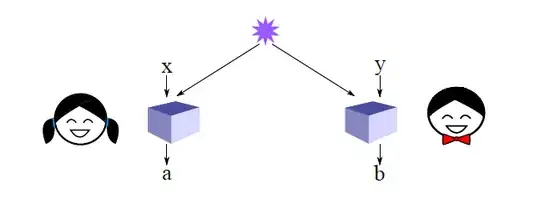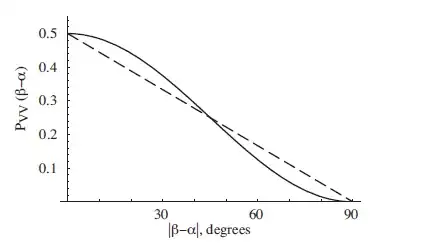I'm aware that the optimality of the quantum strategy for the CHSH game is given by Tsirelson's bound, but presentations all skip over the (admittedly much less interesting) proof of the classical strategy's optimality.
In the CHSH game, we have two players: Alice and Bob. They are separately given independent random bits $X$ and $Y$ as input, and without communication must output bits of their own ($A$ and $B$) with the goal of making true the logical formula $X \cdot Y = A \oplus B$. The claimed optimal classical strategy is for Alice and Bob to both always output $0$, which results in a win 75% of the time:
$\begin{array}{|c|c|c|c|c|c|} \hline X & Y & A & B & X \cdot Y & A \oplus B \\ \hline 0 & 0 & 0 & 0 & 0 & 0 \\ \hline 0 & 1 & 0 & 0 & 0 & 0 \\ \hline 1 & 0 & 0 & 0 & 0 & 0 \\ \hline 1 & 1 & 0 & 0 & 1 & 0 \\ \hline \end{array}$
The quantum strategy (which I go over here) results in a win ~85% of the time. You can use this in a proof of the insufficiency of local hidden variables to explain entanglement as follows:
- Assume qbits decide at time of entanglement how they will collapse (rather than at time of measurement); this means they must carry with them some information (the local hidden variable), and this information can be written as a string of bits.
- Since the information is sufficient to completely describe the way in which the entangled qbits collapse, Alice and Bob could, if given access to that same string of classical bits, simulate the behavior of a shared pair of entangled qbits.
- If Alice and Bob could simulate the behavior of a shared pair of entangled qbits, they could implement the quantum strategy with local classical methods using the pre-shared string of classical bits. Thus, there must exist some classical strategy giving an 85% success rate with some string of bits as input.
- However, there exists no string of bits which enables a classical strategy with success rate above 75%.
- By contradiction, the behavior of entangled particles is not reducible to a string of bits (local hidden variable) and thus the entangled particles must instantaneously affect one another at time of measurement.
I'm interested in the proof of (4). I imagine this proof takes the form of a noncommunicative pair of Turing machines which take as input independent random bits $X$ and $Y$ plus an arbitrary shared bitstring, which then win the CHSH game with probability greater than 75%; presumably this results in some contradiction demonstrating the nonexistence of such TMs. So what is this proof?
Secondarily, which papers have presented a proof of the classical strategy's optimality?
Bonus question: in (1), we claim that the local hidden variable can be written as a string of bits; is there a simple reason why this is the case?

